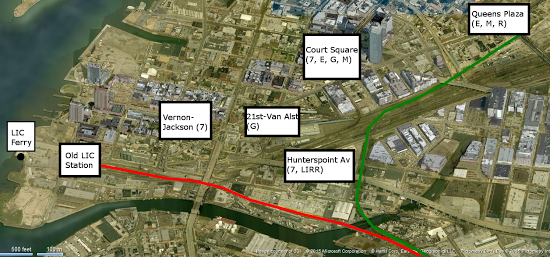
This past weekend, the NYC DOT (very) quietly released their study on creating a new rail transit route through Queens. Let’s take a look at this seemingly futile piece of research into a transit project that won’t exist anytime soon.
The Big takeaways:
Intro
The timing of the release of this report speaks volumes: it was dumped online over the weekend with no fanfare. This is usually a sign that the city government either has no confidence in the report or has no plans to pursue it. The report was sponsored by former councilwoman Liz Crowley, who lost her reelection bid in one of the closest, heated campaigns last year to Bob Holden. Holden has stated he felt the entire report was a huge waste of money, thus it is unlikely he’s interested in pursing passenger rail on this route.
Digging into the report, I had a good laugh upon finding that they used the very same photo we used to illustrate some of Ray Cevoli’s ideas over two years ago right on the cover. What follows is a report that supports our reporting on this topic, and as a rebuke to the developer-driven ‘light rail’ plans presented by the now deposed councilperson Elizabeth Crowley.
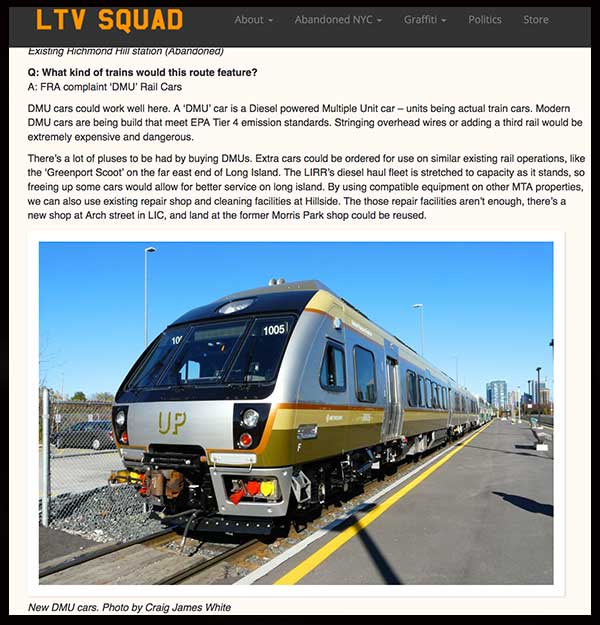
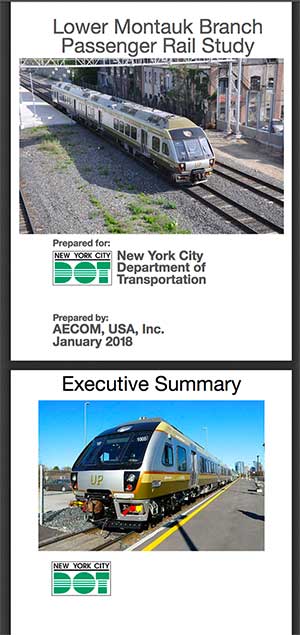
LTV Article two years ago vs. AECOM study cover this month.
Rebuking Crowley and the league of Anti-Freight Fringe Nuts
Crowley spoke of ‘freight trains that threaten us‘. One of her goals by proposing ‘qns-rail’ was the outright elimination of freight rail on these tracks, in direct conflict with United States interstate commerce laws. She admits this again most clearly in a new qns.com article on this topic, where she offers this zinger: “Why do we have to use it for freight? It wasn’t built for freight service“.
Obviously, this lady doesn’t know one thing about the history of industry in Queens. Eliminating freight on these tracks would be a serious blow to the NYC economy, but hey, let’s not let facts get in the way of political corruption eh?
This project should have had more sensible, thoughtful leadership from the start.
“It is also important to recognize that the Branch carries an active rail freight line that serves Long Island and provides support to many Queens-based industries along the line. These businesses are located in some of the few remaining industrial areas left in the city, and are a critical component to the city and region’s growth. As such, the Branch has been identified as an important component of the Cross Harbor Freight Program.” Basically, this report rightfully shifts the narrative away from the lunatic Crowley/’CURES’ fringe idea of eliminating freight movements in NYC, towards one of ‘how can we accommodate both services’. This is literally the only realistic position anyone should take, and conversation we should be having. We need more trucks off our roads and goods moved by rail, not just on the Lower Montauk tracks but on all rail in NYC. Anyone opposed to maintaining freight service in NYC is literally on the side of death.
It is just incredibly sad that we have had to waste this much conversation on a distracting non-starter. This project should have had more sensible, thoughtful leadership from the start. Instead, it’s basically dead due to poorly informed posturing on a single issue. Our city transportation policy should not be being written by a bunch of Glendale NIMBY republican snowflakes who are doing everything they can to get freight trains out of their neighborhood – this despite the tracks existing there long before their backwater neighborhood existed.
The recommended rail equipment choice is one we made two years ago.
I was further amused to read page 5 of the report, which goes straight into recommending DMU rail cars for any service on this branch. If this recommendation sounds familiar, you probably read it here, two years ago. DMUs are the only serious option for providing passenger service to this low-density passenger route while holding construction costs in check.
The pricetag for this project, if it were to include electrification, would have been astoundingly high, perhaps a billion dollars higher. It would require installing overhead wires or third rail along the entire length of the route. It would also drive up maintenance costs year over year, and would beg the question: what would we plug this into? Where would the generating station to support this new large electrical need be placed? Where would the feeder cables be installed? To this end, AECOM’s report is dead(ass) on the money correct by recommending DMUs.
The pricetag for this project, if it were to include electrification, would have been astoundingly high, perhaps a billion dollars higher.
Electrification simply wouldn’t make sense for a route that arguably would not have very dense ridership. Let’s turn to page 6 of the report for those numbers: “Estimated ridership for the Branch is 21,000 weekday and 13,000 weekend daily riders, based on a modeled build year of 2025 under current area growth. Per-station ridership is mixed, with some higher but most lower than the average City subway station.” Now bear in mind, this is a small number compared to most NYC subway routes, but it is significant in that it might provide some relief to the severe crowding conditions taking place on the scant few subway routes that run through Queens. No one is saying there should not be passenger service on the Lower Montauk – we’re just talking about how best to implement it without skyrocketing the costs further into the billions. That best/least costly method would be DMU rail cars. We already know this.
Let’s get into cost a little more.
The report goes on to state that starting transit service on this route would cost over 2 billion dollars -or 1 billion, if freight was eliminated. This statement is false. If we eliminated freight service, we would simply be passing on that billion dollars that were ‘saved’ to taxpayers in the form of trucking costs. NYC’s garbage is shipped out of the city via rail. To remove the yearly tide of 3.2 million tons of garbage, taxpayers would have to foot the bill for a huge new fleet of trucks to transport the trash outside of the city to transload facilities, or all the way to landfills in other states as far away as South Carolina. We’re talking about potentially thousands of trucks and drivers. In the end, eliminating freight on these tracks would actually cost taxpayers far north of one billion dollars.
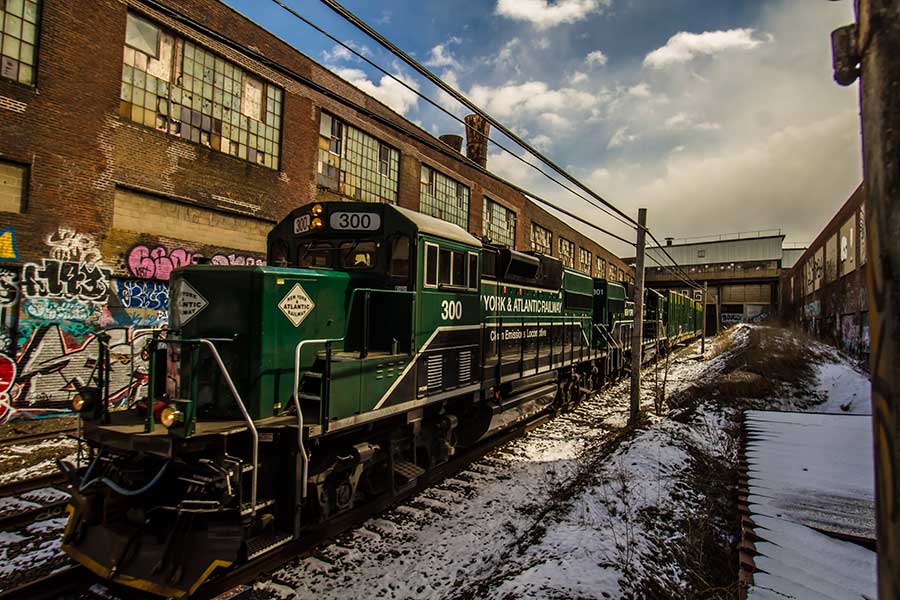
This freight train keeps tens of thousands of trucks off NYC streets.
So let’s get back to that 2 billion figure. This figure includes new train cars, stations, a maintenance facility, and the elimination of three street crossings. Two out of four of these items are ‘pork’. As we mentioned in previous articles, the stations could be constructed without huge cost. The LIRR already owns maintenance facilities at the Jamaica end of the route, and at Arch street in LIC.
Purchasing new DMU rail cars could be paired with Metro North and LIRR needs for additional rail cars that could be used in shuttle operations on non-electrified routes: Greenport and Wassaic for example. That might get us a better deal via combined procurement. It is worth noting that the MTA is scheduled to lease up to 21 passenger cars from a Maryland commuter railway to meet the demands of summer ridership on the LIRR. They quite literally do not have enough diesel cars to provide an effective service right now.

The existing LIRR Arch Street shop could easily maintain any rail cars used on the Lower Montauk route.
Another big, questionable expense: Grade Crossing Elimination
We’ve never covered it on this site because it never seemed worth mentioning. AECOM’s report suggest installing (very expensive) crossing eliminations at three locations: The Waste Management crossing in Blissville, Maspeth Avenue, and 88th street in Glendale. Their recommendation follows federal highway guidelines, though I question how necessary any of these (very expensive) crossings are in reality.
Let’s compare any of these crossings to N. Racine ave in Chicago’s West Loop. Here, dozens of trains roll through this crossing during the day, with a decent amount of auto traffic. Often you’ll have up to three passenger trains speeding through these crossings at the same time. Simple grade crossing protection works here just fine. Thus it is my position that NO expensive grade crossing elimination work would be required.
By eliminating new grade crossing overpasses and redundant maintenance facility, the budget for this project could be brought down to something significantly more reasonable.
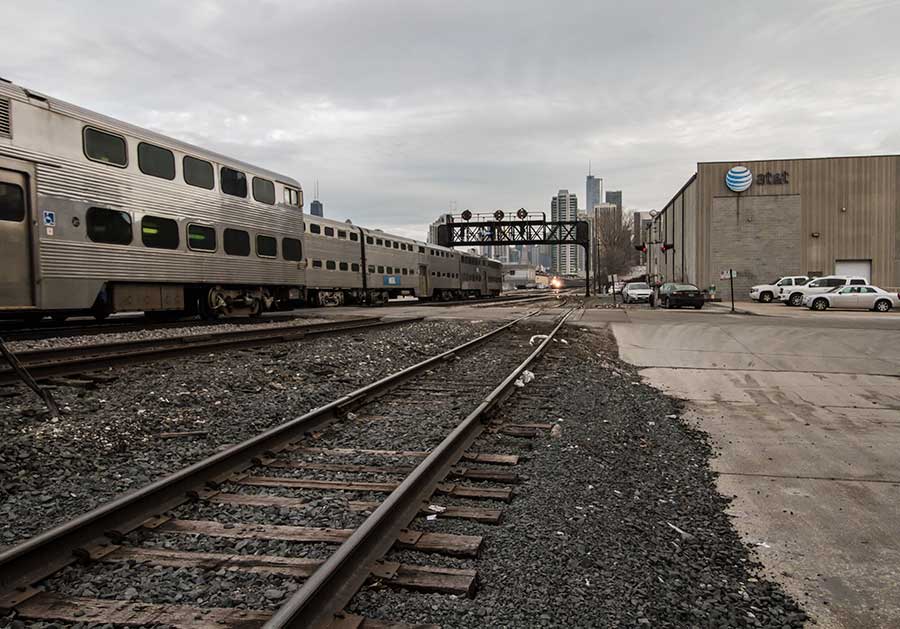
Racine Crossing in Chicago. finding three commuter trains speeding through this five track grade crossing at the same time is not uncommon.
My position is based on cost. To get rid of these crossings, the city would have three options:
1) Close these streets entirely (which is not a realistic option)
2) Build an overpass above the the tracks. This option would entail significant changes to these streets including approach ramps which may not be possible without eminent domain.
3) Build an underpass – again with the same constrains as overpasses. In some locations that are close to newtown creek, an underpass would not be a realistic option.
Construction costs for any of these projects would be a feeding frenzy for corrupt contractors fond of giving politician ‘campaign contribution’ kickbacks. Each would cost deep into the eight figure range. This is pork spending. It needs to be highlighted and exposed.
I also question the assessment that only three of these crossings would require grade separation. Why were these three crossing in particular singled out? The Waste Management crossing in Blissville, for example, sees a very similar amount of traffic as the Greenpoint Avenue crossing, where DSNY trash trucks also cross the tracks at a similar, if not larger frequency than the Waste Management crossing. These trucks use the crossing to access the SIMS recycling transload on Newtown Creek, where residential recyclable materials are unloaded 6 days per week.
Similarly, the 43rd street crossing is listed as ‘low traffic’, another falsehood. Clearly whoever wrote this portion of the report has never visited this location in person. To their credit though, they do mention the new Fed Ex facility here, which absolutely would necessitate closer study since it is designed to accommodate hundreds of truck trips per day.
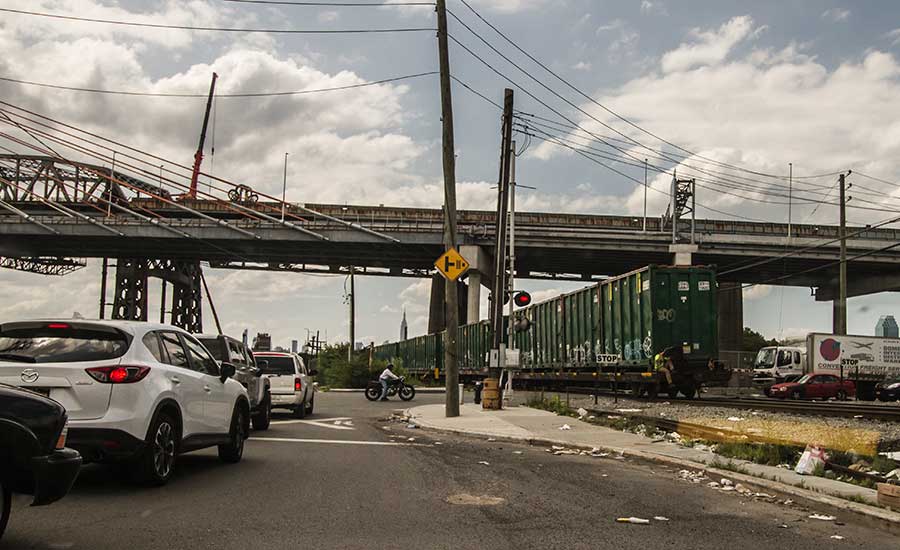
43rd street crossing on a Saturday afternoon, plenty of traffic waiting for NY&A’s trash hauler to pass through.
11th street crossing in LIC is also listed as low traffic. Until Fresh Direct relocates, that is a false statement. This crossing sees at least, Building a grade separation here though would be next to impossible in engineering terms. It is located under the Pulaski bridge, with very little real estate on either side of it.
Without any rhyme or reason to which crossings to eliminate, and clear indications that these recommendations are based off of flawed data, this section of the report can only be rated as garbage. No serious, boots on the ground, observational study went into it.
The studies don’t look at the bigger context of the city & its transportation needs.
Conclusion
I could go on analyzing this report for days. I didn’t go into on real estate development (though I have in the past) or potential riders – or the fact that this report neglects to even consider how commuters would get from LIC to Manhattan.
This last part is probably the biggest flaw in this report and in all of the transit planning talk going on in the halls of city and state government: the studies don’t look at the bigger context of the city & its transportation needs. They don’t look at how service on this route could connect to the Rockaway Beach Branch and drastically increase airport accessibility. They don’t look at how buying extra DMU cars could also benefit Metro North and the LIRR.
It is sad that costs for this project were inflated with significant pork spending. A rail transit route on these tracks, utilizing DMU trainsets, would be very much worth pursing. Instead of dogmatically shrugging this project off by saying ‘who would ride it’, we should compare it to projects like BQX: which is projected to have a comparable number of potential customers for a project projected to cost 2.5 billion dollars, mostly serving neighborhoods with less of a need for a new rail transit route when compared to the transit deserts of central Queens.
Regardless, I found this whole report to be vindicating. Much of what we’ve published on this topic over the last two years has been validated by consultants we have had no contact with whatsoever. The numbers on projected ridership, potential station locations, etc are all good data to get familiar with for that time (long after we’re all dead and even our grandkids have come and gone) when New York City and State agree to do right by commuters by bringing rail commuter service to the Lower Montauk, and perhaps even building a new tunnel from these tracks straight into Manhattan. Hell, let’s extend those tracks all the way to New Jersey, so we can bring freight trains directly from the west onto Long Island without taking a 260 mile detour to Selkirk, bringing down the cost of consumer goods via decreased transportation costs and better infrastructure.
That said, note to elected officials: next time, save half a million dollars and drop me an email. You would have gotten the same and better recommendations with more realistic costs at a fraction of was paid to AECOM.
Leave a Reply